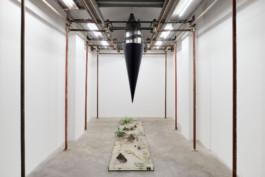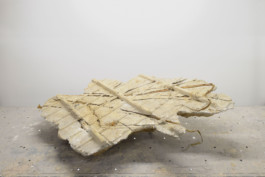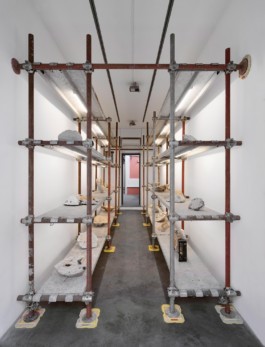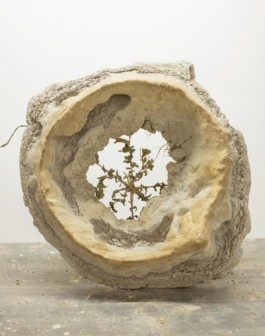Stefano Canto
Sotto L’influenza Del Fiume. Sedimento
28.03.2018 –
19.05.2018

Comunicato stampa | Testo critico
Press release | Exhibition essay
Matèria is pleased to announce the second solo show at the gallery by represented artist Stefano Canto. The exhibition, titled ‘Sotto l’influenza del Fiume. Sedimento’, highlights the artist’s most recent sculptural works and their relationship with the city of Rome.
Within our current timeframe – one characterised by rapid and continuous mutations – the concepts of ephemeral and impermanence (differently from what is born to last) can be considered primary tools for a better understanding of our present human condition.
With his study of ‘liquid modernity’, the Polish sociologist Zygmunt Bauman assigns a few distinctive peculiarities and terms to our contemporary reality, such as: permanent transience, the durability of the ephemeral, inadequate social roles, the uncertainty of the future, fragile social status and existential insecurity.
In ‘liquid life’ everything is constantly changing and being renewed, the past tends to loose its significance and the future appears increasingly distant and unobtainable. This precarious condition is underlined by Marc Augé, through his belief that contemporary society ‘doesn’t aspire to eternity but rather to the present: albeit an unreachable present.’ Furthermore adding that: ‘It doesn’t aspire to a future set in stone but towards an infinitely replaceable present.’
Bauman and Augé’s words paint a clear picture of contemporary reality and underline the importance of the concepts of ephemeral and impermanence as essential tools to observe our present events. In the context of a society that negates the existence of a past and a future – remaining trapped in an eternal present – the role of the archeologist (one that gives new life to the artifact), and the role of the artist (the creator) appear to overlap. The result is the birth of the artist-archeologist that takes on a key role, embodying two fundamental aspects: the interpretation of the signs of a society floating in the present, and that of the promoter of creative processes, therefore becoming the guarantor of a cyclical artistic creation. The body of work ‘Archeology of the Ephemeral’ is comprised of a series of sculptures that vary in form and measure, constructed with selected materials such as ice and cement powder. Every artwork is created in three steps, the first where the elements are placed in dialogue within a space, the intermediary phase where the elements interact – the ice melts and the cement consolidates – and the final one where the excess of matter is brushed off.
The time required between the first and the third phase depends on the volume and size of the elements used. The last phase should not be interpreted as the final form of the artwork but rather as a part of the process where order and importance do not exist, where the fundamental quality is the life cycle.
The exhibition ‘Sotto l’influenza del Fiume. Sedimento’ falls within the research spectrum initiated by Canto with ‘Archeologia dell’Effimero’ (2016), adding a new chapter to a process born with ‘Geografia in Contrazione’ (2011); a body of work that incorporates natural elements – plucked from uncontaminated areas of the city – within blocks of cement in order to create indecipherable archives of our contemporary landscape.
In ‘Sotto l’influenza del Fiume. Sedimento’, the Tiber embodies the starting point fo a reflection on the metropolis; its riverbed is where the city can be found in its true form, characterised by a state of constant mutation. Architectural fragments belonging to different timeframes, alongside organic and non-organic matter of all kinds are accumulated and muddled in one single and homogenous grey mass, composed of infinite layers and stratifications in constant flux.
This architectural magma finds its solidification (lithification) within large scale tanks placed in the gallery space and utilised to recreate the Tiber’s microcosm. The cement powder slowly released by a high standing machine specifically designed by the Artist, activates an accelerated process of sedimentation referencing the ‘liquid’ city, resulting in a series of highly emblematic contemporary fossils.





